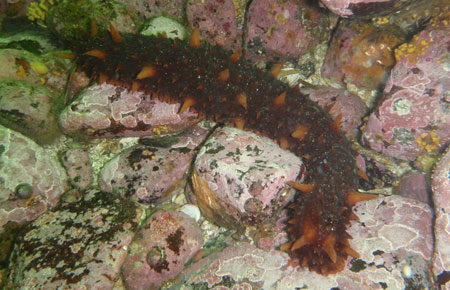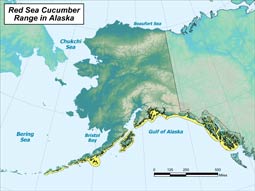Red Sea Cucumber
(Apostichopus californicus)
Species Profile
Did You Know?
Sea cucumbers can regenerate all parts of its body.
General Description
The red sea cucumber is part of the Phylum Echinodermata and the Class Holothuroideaia. It can grow to a length of 50 cm and a width of 5 cm, and when drained of fluids can weigh up to 500 grams. It has a soft, cylindrical body, with red-brown to yellowish leathery skin. It has an endoskeleton just below the skin. The mouth and anus are on opposite ends of the body. The mouth is surrounded by twenty retractable tentacles that are used to bring food in. Five rows of tube feet extend from the mouth to the anus. Tube feet are densely arranged on the ventral side and only three pairs of rows are distinct. Mobility is limited, though individuals can move up to 4 m per day while feeding. They use their tube feet located on the underside of their body. When threatened, it can expel all its stomach contents through its anus until its next feed. It has the ability to regenerate all parts of its body. It can also expel sticky filaments to ensnare or confuse predators.
Life History
Growth and Reproduction
Maturity is estimated to occur between 4 and 8 years of age and the maximum age is estimated as 12 years in British Columbia. Males and females are separate, breeding occurs in the summer, and development is indirect. The sperm have spherical heads and an unusually low DNA content. The fertilized eggs develop into auricularia larvae which metamorphose into doliolaria larva which settle. The pelagic phase lasts from 7 to 13 weeks in the laboratory.
Feeding Ecology
This species is an epifaunal deposit feeder, feeding on organic detritus and small organisms and acting as a “bioturbator” that reworks and redistributes sediment in the process of feeding.
The hindgut bears a pair of highly branched diverticula, which project into the coelomic cavity of the body and serve as water lungs. Oxygenated water is pumped into these respiratory trees in several successive inhalations and then expelled in one powerful exhalation.
Migration
It is common for red sea cucumbers to undertake seasonal migrations to different depths. Mobility is limited so long distance migrations are not common.
Range and Habitat
It is a common species distributed from Mexico to Southeast Alaska and has been observed at least as far west and north as the Alaska Peninsula, Aleutian Islands, and Bering Sea. The abundance of sea cucumbers in Southeast Alaska is greatest in the southern and western portions in protected bays and inlets.
These sea cucumbers exist in a range of habitat types ranging from shell debris and gravel, mud and silt, and even exist on rock and boulders. A study conducted in Southeast Alaska showed that the most common habitat for sea cucumbers was shell debris and gravel. It occupies a broad range of subtidal habitats from nearshore shallows to over 100 fathoms. P. californicus appears to favor locations with moderate current, avoiding mud bottoms and areas subject to inundation by freshwater or glacial runoff.
Fast Facts
-
Size
Up to 50 cm long, up to 5 cm wide, up to 500 grams drained weight -
Range/Distribution
West coast of North America, Mexico to Bering Sea -
Diet
Plankton and organic matter -
Predators
Sea otters, fish, crabs, sea stars -
Reproduction
Males and females separate, fertilization is external -
Remarks
In Alaska, managed by the Alaska Department of Fish and Game


